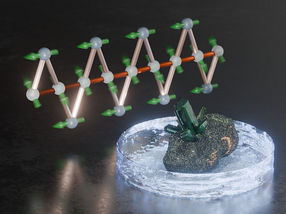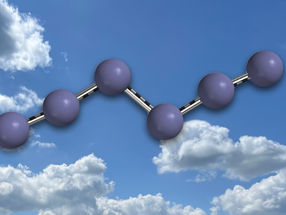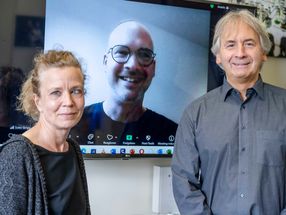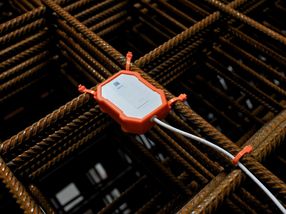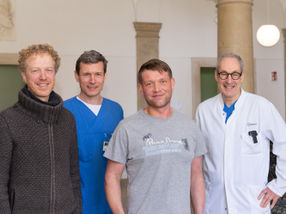Ferromagnetism plus Superconductivity
Researchers Discover a Rare Physical Phenomenon at Low Temperatures and High Magnetic Fields
It actually seems impossible: Scientists from the Helmholtz-Zentrum Dresden-Rossendorf (HZDR) and theTU Dresdenwere able to verify with an intermetallic compound of bismuth and nickel that certain materials actually exhibit the two contrary properties of superconductivity and ferromagnetism at the same time. A phenomenon that had only been demonstrated around the globe on a small number of materials and which might provide highly interesting technological opportunities in future.

Image from a scanning electron microscope showing a bundle of parallel-oriented Bi3Ni fibers which become both ferromagnetic and superconducting at low temperatures. Looking into such a fiber, one will discover an only few nanometer wide atomic lattice structure made out of bismuth (blue) and nickel atoms (green).
Just in time for the 100th anniversary to commemorate the discovery of superconductivity by the Dutch physicist Heike Kamerlingh Onnes on April 8, 1911, scientists from the Helmholtz-Zentrum Dresden-Rossendorf and the TU Dresden published their research results in the journal Physical Review B. Headed by Dr. Thomas Herrmannsdörfer, the team from the HZDR’s High Magnetic Field Laboratory (HLD) examined a material consisting of the elements bismuth and nickel (Bi3Ni) with a diameter of only a few nanometers – which is unique since it has not been achieved elsewhere so far. This was made possible through a new chemical synthesis procedure at low temperatures which had been developed at the TU Dresden under the leadership of Prof. Michael Ruck. The nano scale size and the special form of the intermetallic compound – namely, tiny fibers – caused the physical properties of the material, which is non-magnetic under normal conditions, to change so dramatically. This is a particularly impressive example of the excellent opportunities modern nanotechnology can provide today, emphasizes Dr. Thomas Herrmannsdörfer. “It’s really surprising to which extend the properties of a substance can vary if one manages to reduce their size to the nanometer scale.”
There are numerous materials which become superconducting at ultralow temperatures. However, this property competes with ferromagnetism which normally suppresses superconductivity. This does not happen with the analyzed compound: Here, the Dresden researchers discovered with their experiments in high magnetic fields and at ultralow temperatures that the nanostructured material exhibits completely different properties than larger-sized samples of the same material. What’s most surprising: The compound is both ferromagnetic and superconducting at the same time. It is, thus, one of those rarely known materials which exhibit this unusual and physically not yet completely understood combination. Perhaps bismuth-3-nickel features a special type of superconductivity, says Dr. Herrmannsdörfer. The physicist and doctoral candidate Richard Skrotzki, who has just turned 25, is making a vital contribution to the research results and describes the phenomenon as “the bundling of contrary properties in a single strand.”
The TU Dresden and the HZDR are partners in the research allianceDRESDEN-conceptwhich pursues the objective of making visible the excellence of Dresden research.
Original publication
Most read news
Original publication
T. Herrmannsdörfer, R. Skrotzki, J. Wosnitza, D. Köhler, R. Boldt, and M. Ruck; "Structure-induced coexistence of ferromagnetic and superconducting states of single-phase Bi3Ni seen via magnetization and resistance measurements"; Phys. Rev. B 83, 140501(R) (2011)
Organizations
Other news from the department science

Get the chemical industry in your inbox
By submitting this form you agree that LUMITOS AG will send you the newsletter(s) selected above by email. Your data will not be passed on to third parties. Your data will be stored and processed in accordance with our data protection regulations. LUMITOS may contact you by email for the purpose of advertising or market and opinion surveys. You can revoke your consent at any time without giving reasons to LUMITOS AG, Ernst-Augustin-Str. 2, 12489 Berlin, Germany or by e-mail at revoke@lumitos.com with effect for the future. In addition, each email contains a link to unsubscribe from the corresponding newsletter.

















